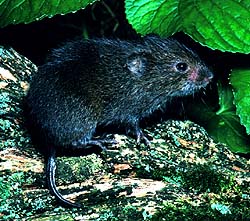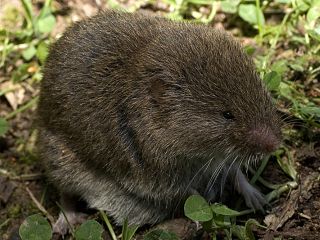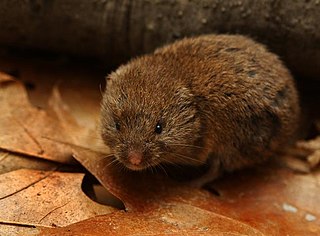
The Arvicolinae are a subfamily of rodents that includes the voles, lemmings, and muskrats. They are most closely related to the other subfamilies in the Cricetidae. Some authorities place the subfamily Arvicolinae in the family Muridae along with all other members of the superfamily Muroidea. Some refer to the subfamily as the Microtinae or rank the taxon as a full family, the Arvicolidae.

Microtus is a genus of voles found in North America, Europe and northern Asia. The genus name refers to the small ears of these animals. About 62 species are placed in the genus. They are stout rodents with short ears, legs and tails. They eat green vegetation such as grasses and sedges in summer, and grains, seeds, root and bark at other times. The genus is also called "meadow voles".

The Bavarian pine vole is a vole from the Austrian, Italian, and Bavarian Alps of Europe. It lives in moist meadows at elevations of 600 to 1,000 meters. There are 23 museum specimens of this species. This rodent was previously known to live in only one location, Garmisch-Partenkirchen in Bavaria, which was altered by the construction of a hospital in the 1980s. No specimens of this rodent were recorded after 1962 and it was thought to be extinct. However, a population apparently belonging to this species was discovered in 2000 in Northern Tyrol, just across the German-Austrian border. An Austrian scientist, Friederike Spitzenberger, stumbled upon the species in a live trap. Its species status was confirmed by genetic studies, and it was found to be very closely related to Liechtenstein's vole from the Eastern Alps. Further research is required to determine the size and range of the population and the species has been re-assessed as Critically Endangered by the IUCN.

The Tatra pine vole, also called the Tatra vole or Tatra ground vole, is a species of vole endemic to the Carpathian mountain range in Slovakia, Poland, Ukraine and Romania. Two subspecies have been recognised. M. t. tatricus occupies the western part of the range in Slovakia and Poland, and M. t. zykovi is found in Ukraine and Romania.

Victor Fatio, was a Swiss zoologist.
Blanfordimys is a subgenus of voles in the family Microtus. It was formerly considered a distinct genus, but taxonomic studies group it within the Microtus radiation.
The Mediterranean pine vole is a species of rodent in the family Cricetidae. It is found in France, Andorra, Portugal, and Spain where it lives in a network of shallow tunnels.

The narrow-headed vole is a species of rodent in the family Cricetidae. Ranging over northern and central Asia and also into Alaska, it is the only species in the subgenus Stenocranius.
The juniper vole is a species of rodent in the family Cricetidae. It is found in Afghanistan, China, Pakistan and Tajikistan. It was formerly classified in the genus Neodon, but genetic evidence indicates that it is classified within the subgenus Blanfordimys in Microtus.

The creeping vole, sometimes known as the Oregon meadow mouse, is a small rodent in the family Cricetidae. Ranging across the Pacific Northwest of North America, it is found in forests, grasslands, woodlands, and chaparral environments. The small-tailed, furry, brownish-gray mammal was first described in the scientific literature in 1839, from a specimen collected near the mouth of the Columbia River. The smallest vole in its range, it weighs around 19 g (0.67 oz). At birth, they weigh 1.6 g (0.056 oz), are naked, pink, unable to open their eyes, and the ear flaps completely cover the ear openings. Although not always common throughout their range, there are no major concerns for their survival as a species.

Savi's pine vole is a species of rodent in the family Cricetidae. It is found in France and Italy.
Schelkovnikov's pine vole is a species of rodent in the family Cricetidae. It is found in Azerbaijan and Iran. It has recently been considered the sole species in the subgenus Hyrcanicola.

The European pine vole, also known as the common pine vole, is a species of rodent in the family Cricetidae. It is native to much of Europe and parts of Asia.
The Zempoaltépec vole is a species of rodent in the family Cricetidae. The name Microtus is from the Greek word mikros meaning small and otus meaning ear. The name umbrosus could be from the Latin umbros meaning shady. It is rather large and has a long tail when compared with other voles. Its pelage is long and soft. In the upper parts, the hair is uniformly dusky with brown tips and the lower parts a dark grey thinly washed with a reddish yellow color. It is found only in Mexico, in a semi-isolated mountain range southeast of the Cajones River in Mixes district, in Oaxaca.

Arvicolini is a tribe of voles in the subfamily Arvicolinae.
The Qazvin vole is a species of rodent in the family Cricetidae. It is found in Iran and is normally given as either part of the Microtus or Sumeriomys subgenus. It is a close relative of M. guentheri distinguished by different pelage coloration and a more complex occlusal pattern.

Pitymys is a subgenus of voles in the genus Microtus. Species in this subgenus are:

Alexandromys is a subgenus of voles in the genus Microtus. Species in this subgenus are:

Mynomes is a North American subgenus of voles in the genus Microtus. Species in this subgenus are:

Igor Zagorodniuk is a Ukrainian zoologist, mammalogist, ecologist, and founder of Theriological school. He is a laureate of the State Prize of Ukraine in the field of science and technology (2015), and the author of more than 500 scientific publications.
D.E. Wilson & D.M. Reeder, 2005: Mammal Species of the World: A Taxonomic and Geographic Reference. Third Edition. The Johns Hopkins University Press, Baltimore.












